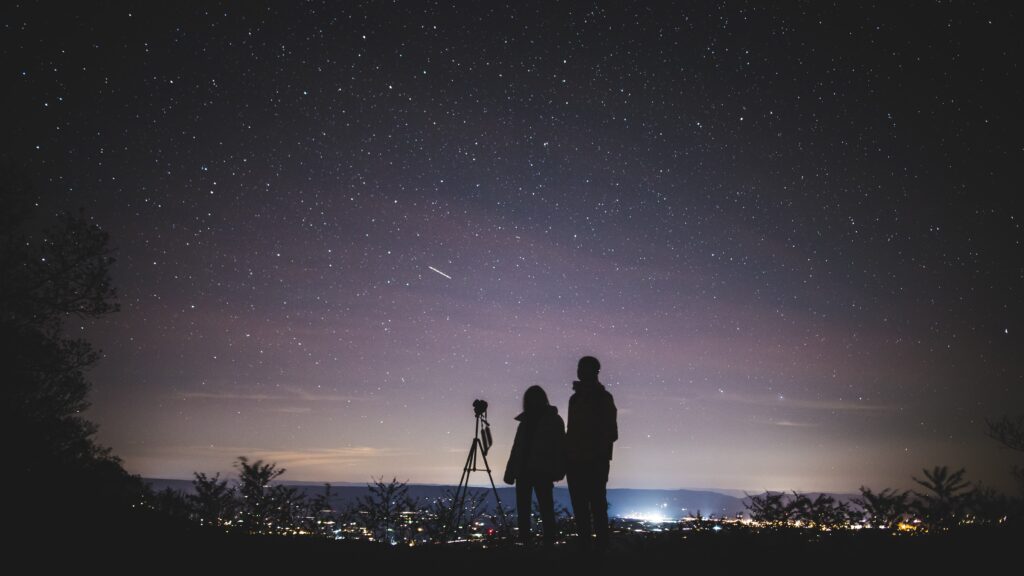
Discover the Night Sky: Upcoming Celestial Events
Looking up at the night sky has captivated humanity for millennia. Join us as we explore the wonders of the cosmos, right from your own backyard! This page highlights upcoming astronomical events that you can observe without the need for fancy telescopes or special equipment. From meteor showers to planetary conjunctions, there’s something for everyone to enjoy. So grab a blanket, find a dark spot, and let’s embark on a celestial adventure together.
NOVEMBER 2024
TAURID METEOR SHOWER (Early November)
November begins with the Taurid meteor shower, a slow but steady shower peaking in the first week and likely best on the 4th. The Taurids are an unusual shower because they comprise meteors from two separate streams of debris—one from dust left by Asteroid 2004 TG10 and the other from Comet 2P Encke. Light from the 1st-quarter Moon will swamp all by the brightest Taurids, but, once the Moon sets around midnight, you just might spot fainter meteors that are part of the Taurid show.
FULL BEAVER MOON (November 15)
November’s full Moon is traditionally called the Beaver Moon, a name rooted in Native American customs related to setting beaver traps before winter. Known by other peoples as the Dark Moon and the Frosty Moon, this month’s full Moon is the last of three supermoons for 2024—“supermoon” in that it appears slightly larger and brighter in the sky because its orbital location will be near its closest approach to Earth. The Beaver Moon, like all full Moons, rises right at sunset and sets the next morning at sunrise.
MERCURY (November 16)
As Earth’s planetary siblings orbit the Sun, we see their orbital motions manifest in motions across our sky. Mercury, innermost and swiftest moving planet, swings quickly in motions from one side of the Sun to the other. On the 16th, Mercury reaches “greatest eastern elongation” and will appear more than 20 degrees from the Sun (your fist at arm’s length is 10 degrees): we will have our best opportunity tonight to see tiny Mercury, which, just as Sol sets, will be about two fist widths (20 degrees!) above the western horizon.
LEONID METEOR SHOWER (Mid-November)
One of the year’s most famous meteor showers, the Leonids occur when Earth passes through the debris stream of Comet Tempel-Tuttle. In 2024, the shower will peak on the night of November 17 and into the predawn of November 18. Expect around 15 meteors/hour at peak, meteors’ streaks radiating from the direction of the constellation Leo (hence the name, Leonids). Unfortunately, light from a nearly full Moon will this year significantly reduce visibility.
DECEMBER 2024
JUPITER (December 7)
Just three weeks after Mercury’s greatest eastern elongation, mighty Jupiter is “at opposition” in our December sky and closest then to Earth in its orbit around the Sun. On the 7th, Jupiter will be as far as possible from the Sun in our sky, rising in the east just as the Sun sets in the west. The largest planet will be unmistakable in the eastern sky. With a set of binoculars, you will even be able to spot Jupiter’s four brightest moons, Io, Callisto, Europa, and Ganymede—the so-called Galilean satellites.
GEMINID METEOR SHOWER (Mid-December)
The Geminids, peaking on December 13-14 and appearing to radiate from the direction of the constellation Gemini, is arguably the best meteor shower of the year, with rates of up to 120 meteors per hour. These bright, fast meteors originate when Earth passes through debris ejected by the asteroid 3200 Phaethon and are often vibrant in color, ranging from yellow to blue and green. Unfortunately, a nearly full Moon will take away our view of all but the brightest Geminids.
FULL COLD MOON (December 15)
The December full Moon, known as the Cold Moon, is aptly named as it accompanies the onset of frigid temperatures and long, dark nights in the Northern Hemisphere. Other names for this month’s full Moon include the Long Nights Moon and the Moon Before Yule.
WINTER SOLSTICE (December 21)
At 4:20am EST on December 21, the Northern Hemisphere experiences the winter solstice, marking the shortest day of the year and the official start of winter for us in the north. For family and friends in the Southern Hemisphere, however, this time marks the start there of summer! For us northerners, the daylight will be brief and nights long—albeit with more opportunities for skygazing.
MERCURY (December 25)
Having hopefully spotted Mercury on November 16 at its greatest eastern elongation, you can before dawn this morning spot the quick-moving world at its greatest western elongation from the Sun in our sky—and at its highest point above the horizon in the morning sky.
JANUARY 2025
MOON, VENUS & SATURN (January 3)
January kicks off with a terrific sight in the early evening sky. Look in the western sky as night arrives, and there, less than half the width of your fist at arm’s length, will be a young waxing crescent Moon and vivid Venus. Let your gaze move ten degrees up and to the left of that pair, and you will spot Saturn. An exquisite triple for the night! Watch over the next few nights how the three appear to move relative to each other.
QUADRANTID METEOR SHOWER (Early January)
The Quadrantid meteor shower will be visible from January 1-5 and should peak around January 3-4. Finally! After the Leonids and Geminids being washed out in late 2024 by light from the Moon, we will have opportunity to see a good meteor shower when Earth intersects the debris stream from ancient Comet (or is it an asteroid?) 2003 EH1. The waxing crescent Moon will set before midnight, and it may be possible to see up to 40 Quadrantids per hour.
EARTH (January 4)
Earth at 8:28am EST on January 4 reaches perihelion, the closest point to the Sun in its elliptical orbit around the star.
VENUS (January 10)
Let’s notice Venus’s position in the sky relative to the Sun. On January 10, that planet, with an orbit inside Earth’s around the Sun, will reach greatest eastern elongation (about 47 degrees) from the Sun in our sky. You will be able to catch Venus on the 10th by looking low in the western sky right after sunset—and, at the same time on subsequent days, you will notice Venus is lower and lower above the horizon as its orbit appears to carry it closer to the Sun in our sky.
FULL WOLF MOON (January 13)
January’s full Moon will rise at sunset on January 13 and set at sunrise the next morning. Known as the Wolf Moon as well as the Old Moon and Moon After Yule, this month’s full Moon was so-named by early Native Americans who heard packs of hungry wolves in the night.
MARS (January 16)
Mars’s orbit around the Sun is larger than Earth’s, and, as a consequence, it takes the Red Planet 1.88 Earth years to complete an orbit. On January 16, Mars is closest to Earth in its orbit and, rising as the Sun sets, will be opposite in the sky to the Sun.
SKY STROLLING
Naked-Eye Observing for Winter Constellations
Best Time:
Winter constellations are visible from early evening through the night, starting around an hour after sunset. For the clearest views, aim to observe between 8:00pm and 10:00pm local time, when most of the “winter” constellations are high in the sky. (We’ll discuss in a future “View from the Mountain” why there are different constellations visible in different times of the years!).
Location:
Find a dark location away from city lights for the best visibility. The farther you are from light pollution, the more stars you’ll be able to see.
Weather:
Choose a night with clear skies and minimal cloud cover. Cold, dry winter nights often offer the best stargazing conditions.
Tools:
Though no equipment is necessary, a basic star map or a stargazing app can be helpful for orientation. Naturally, dress warmly and consider having a thermos of hot chocolate with you.



